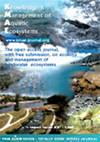两种亚热带食鱼鱼类对沉积物扰动和水质的影响:对放养鱼类恢复的启示
IF 1.7
3区 环境科学与生态学
Q3 FISHERIES
引用次数: 0
摘要
亚热带湖泊通常以底栖杂食性鱼类(如鲫鱼)为主,它们可能严重扰乱沉积物,从而增加水的浑浊度和营养物质浓度。鱼类放养有时被用来控制这些底栖杂食动物,以期减少它们对水质的不利影响。然而,在亚热带浅水湖泊中,食鱼鱼类的底栖觅食活动也可能扰乱沉积物,这一主题尚未得到很好的阐明。本研究通过为期6天的中生态实验,探讨了两种亚热带原生鱼食性鱼类(黑头鱼和鳜鱼)在存在和不存在情景下对猎物鱼(鲫鱼)的生物扰动效应。结果表明,在没有猎物的中食性环境中,黑头鱼和鳜鱼的悬浮物浓度均显著增加。但总悬浮物、有机悬浮物和无机悬浮物浓度均显著高于鳜鱼,表明鱼头具有比鳜鱼更高的生物扰动效应。当鲫鱼存在时,我们发现黑头鱼和鳜鱼都显著降低了猎物丰度,而鱼鱼放养没有显著降低悬浮物和营养物质浓度。研究结果表明,两种亚热带食鱼鱼类对沉积物扰动和水质的影响存在差异,因此在放养食鱼的湖泊恢复中,鳜鱼比黑头鱼更好,因为它们的捕食效果相同,但鳜鱼对沉积物的扰动强度低于黑头鱼。本文章由计算机程序翻译,如有差异,请以英文原文为准。
Effects of two subtropical piscivorous fish species on sediment disturbance and water quality: Implication for restoration by stocking piscivores
Subtropical lakes are often dominated by benthi-omnivorous fish ( e.g. , crucian carp) that may substantially disturb sediments and thereby increase water turbidity and nutrient concentrations. Piscivores stocking is sometimes used to control these benthi-omnivores in the expectation that they will reduce their adverse effects on the water quality. However, in shallow subtropical lakes the benthic foraging activities of piscivorous fish may also disturb sediments, a topic that has not yet been well elucidated. Here, we conducted a 6-day mesocosm experiment to explore the bioturbation effects of two native subtropical piscivorous fish ( i.e. , snakehead, Channa argus and mandarin fish, Siniperca chuatsi ) in prey fish (crucian carp, Carassius carassius ) present and absent scenarios. Our results showed that in mesocosms without prey, both snakehead and mandarin fish greatly increased the concentrations of suspended solids. However, the concentrations of total, organic and inorganic suspended solids were significantly higher in the mesocosms with snakehead than in those with mandarin fish, suggesting that snakehead has higher bioturbation effects than mandarin fish. When crucian carp were present, we found that both snakehead and mandarin fish significantly reduced prey abundance, whereas piscivore stocking did not significantly decrease the suspended solids and nutrient concentrations. Our study revealed differential effects of two subtropical piscivorous fish species on sediment disturbance and water quality, and we suggest that for lake restoration with piscivores stocking, mandarin fish are a better option than snakehead fish as their predation effect was equal but the strength of sediment disturbance by mandarin fish was lower than that of snakehead.
求助全文
通过发布文献求助,成功后即可免费获取论文全文。
去求助
来源期刊

Knowledge and Management of Aquatic Ecosystems
环境科学-海洋与淡水生物学
CiteScore
3.70
自引率
5.60%
发文量
22
审稿时长
>12 weeks
期刊介绍:
Knowledge and Management of Aquatic Ecosystems (KMAE-Bulletin Français de la Pêche et de la Pisciculture since 1928) serves as a foundation for scientific advice across the broad spectrum of management and conservation issues related to freshwater ecosystems.
The journal publishes articles, short communications, reviews, comments and replies that contribute to a scientific understanding of freshwater ecosystems and the impact of human activities upon these systems. Its scope includes economic, social, and public administration studies, in so far as they are directly concerned with the management of freshwater ecosystems (e.g. European Water Framework Directive, USA Clean Water Act, Canadian Water Quality Guidelines, …) and prove of general interest to freshwater specialists. Papers on insular freshwater ecosystems and on transitional waters are welcome. KMAE is not a preferred journal for taxonomical, physiological, biological, toxicological studies, unless a clear link to ecological aspects can be established. Articles with a very descriptive content can be accepted if they are part of a broader ecological context.
 求助内容:
求助内容: 应助结果提醒方式:
应助结果提醒方式:


